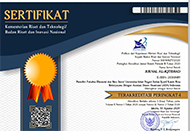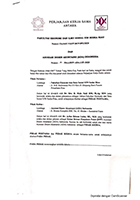OVERVIEW OF HISTORY THOUGHTS ON THE ESTABLISHMENT OF ISLAMIC BANKS IN INDONESIA
Abstract
Islamic economic thought in Indonesia is not something that suddenly appears on the surface without any basis but is present because of the presence of figures who bring the concept of thought that becomes theoretical Islamic economics. This thought must be examined and found traces of historical truth. The purpose of this research focuses on the discussion of the history of Islamic economic thought in Indonesia and the history of the institutionalization of Islamic economics and Islamic banks in Indonesia. This research method is a qualitative literature study of journal articles and relevant documents. The results of this study indicate that the history of Islamic economics in Indonesia began with the entry of Islam into Indonesia and the establishment of Islamic kingdoms in the archipelago (Indonesia). Islam had spread in Sumatra in 1200 AD (597 Hijriyah). The practice of trade tax carried out by the Islamic kingdoms of the archipelago referred to what had been practiced in the kingdoms originating from the Middle East. Then trade practices began to be written in Mirât al-Thullâb by Shaykh Abdul Ra'uf al-Sinkili which became a source of Islamic economic thought. Meanwhile, the establishment of Islamic banks was a collaboration between the Indonesian Muslim Scholars Association and MUI. The participation of Indonesian President Soeharto as the initiator of the establishment of the first Sharia bank in Indonesia, as well as the personal role of several former ministers and ministers of the Development V cabinet. With a capital of Rp.116 billion, the Islamic bank began operations on 1 May 1992.
Keywords
Full Text:
PDFReferences
Ahmad, A. (2000). Instruments of Regulation and Control of Islamic Banks By The Central Banks. Islamic Development Bank.
Aji, C. B., Yafiz, M., & Sukiati. (2017). Pemikiran Ekonomi Islam Indonesia (Studi Pemikiran Cendekiawan Muslim Indonesia Era Pra-Kemerdekaan-Orde Baru). Al Muamalat Jurnal Hukum Ekonomi Syariah, 2(2), 35–51.
Badruzaman, D. (2019). Ekonomi Islam dan Politik Hukum di Indonesia. Akualita, 2(2), 569–583.
Darmawan, B. M. (2020). Pascasarjana universitas islam negeri ( uin ) antasari hukum ekonomi syariah banjarmasin.
Habibullah, E. S. (2017). Hukum Ekonomi Syariah Dalam Tatanan Hukum Nasional. Al-Mashlahah: Jurnal Hukum Islam Dan Pranata Sosial, 5(9), 691–710.
Idwal. (2019). Sejarah Perkembangan Lembaga Keuangan Syariah. Jurnal Iqtishaduna, 9(3), 12–42. http://downloads.esri.com/archydro/archydro/Doc/Overview of Arc Hydro terrain preprocessing workflows.pdf%0Ahttps://doi.org/10.1016/j.jhydrol.2017.11.003%0Ahttp://sites.tufts.edu/gis/files/2013/11/Watershed-and-Drainage-Delineation-by-Pour-Point.pdf%0Awww
Kadir, S. (2019). Pengembangan Pengukuran Kinerja Dengan Pendekatan Maslahah Score Card. Ad-Deenar: Jurnal Ekonomi Dan Bisnis Islam, 3(2), 75–96. https://doi.org/10.30868/ad.v3i01.501
Kadir, S. (2022). Labelizing of Manufacturing Halal Industry Products for Achieving Customer Satisfaction In The Perspective of Maslahah Daruriyah. El-Qish: Journal of Islamic Economics, 2(1), 23–31. https://doi.org/10.33830/elqish.v2i1.4150.2022
Kadir, S., Abdullah, M. W., & Kadir, A. (2019). Analisis Pengukuran Kinerja dengan Pendekatan Maslahah Scorecard. Jurnal Minds: Manajemen Ide Dan Inspirasi, 6(1), 53. https://doi.org/10.24252/minds.v6i1.8108
Kadir, S., Fahrika, A. I., & Misbach, I. (2024). Conventional Fiscal Policy System and Islamic Economics in The Indonesian Economy. Widya Cipta: Jurnal Sekretari Dan Manajemen, 8(1), 72–79. https://doi.org/10.31294/widyacipta.v8i1.17149
Loir, H. C. (2000). The History of A History: The Variant Versions of The Sulalat Al-Salatin. In Defence of History, 33(1), 1091–1112.
Nursalam. (2016). Metode Penelitian: Pendekatan Praktis. In Salemba (Issue 4).
Othman, S. H., Yeoh, M. S., Zakaria, R. A., & Hanafiah, M. G. (2019). Aspek Muamalat Dalam Kitab Mir’At Al-Tullab Karya Shaykh Abdul Rauf Ali Al-Singkili. Jurnal Ulwan, 4(November 2018), 1–13.
Qoyum, A., Nurhalim, A., Fithriady, |, Dwi, M., Nurizal, P. |, Mohammad, I., Khalifah, H. |, Ali, M., Ekonomi, D., Syariah, K., & Indonesia, B. (2021). Sejarah Pemikiran Ekonomi Islam.
Saeed, A. (1996). Islamic Banking and Interest : A Study of the Prohibition of Riba And its Contemporary Interpretation. In Journal of King Abdulaziz University-Islamic Economics. Leiden. https://doi.org/10.4197/islec.17-2.8
Santi, M. (2019). Perkembangan Ekonomi Syariah Di Indonesia. Jurnal Eksyar (Jurnal Ekonomi Syariah), 07(01), 47–56. http://ejournal.staim-tulungagung.ac.id/index.php/Eksyar
Shandy Utama, A. (2018). Sejarah dan Perkembangan Regulasi Mengenai Perbankan Syariah Dalam Sistem Hukum Nasional Di Indonesia. Jurnal Wawasan Yuridika, 2(2), 187. https://doi.org/10.25072/jwy.v2i2.180
Sofyan, S. (2016). Perkembangan Perbankan Syariah Di Indonesia. Bilancia, 10(2), 91–112.
Suryani. (2012). Sistem Perbankan Islam di Indonesia: Sejarah dan Prospek Pengembangan. Muqtasid: Jurnal Ekonomi Dan Perbankan Syariah, 3(1), 111. https://doi.org/10.18326/muqtasid.v3i1.111-131
Syarif, F. (2019). Perkembangan Hukum Ekonomi Syariah di Indonesia. Pleno Jure, 8(2), 1–16. https://doi.org/10.37541/plenojure.v8i2.38
Tasriani, & Febria, D. (2022). Etika Distribusi Dalam Ekonomi Islam. Al-Iqtishad, 18(1), 167–189.
Tewksbury, A. S. D. and R. (2013). How to write a literature review (2). JOURNAL OF CRIMINAL JUSTICE EDUCATION, 24(2), 7–11.
DOI: http://dx.doi.org/10.24014/jiq.v20i1.23905
Refbacks
- There are currently no refbacks.















